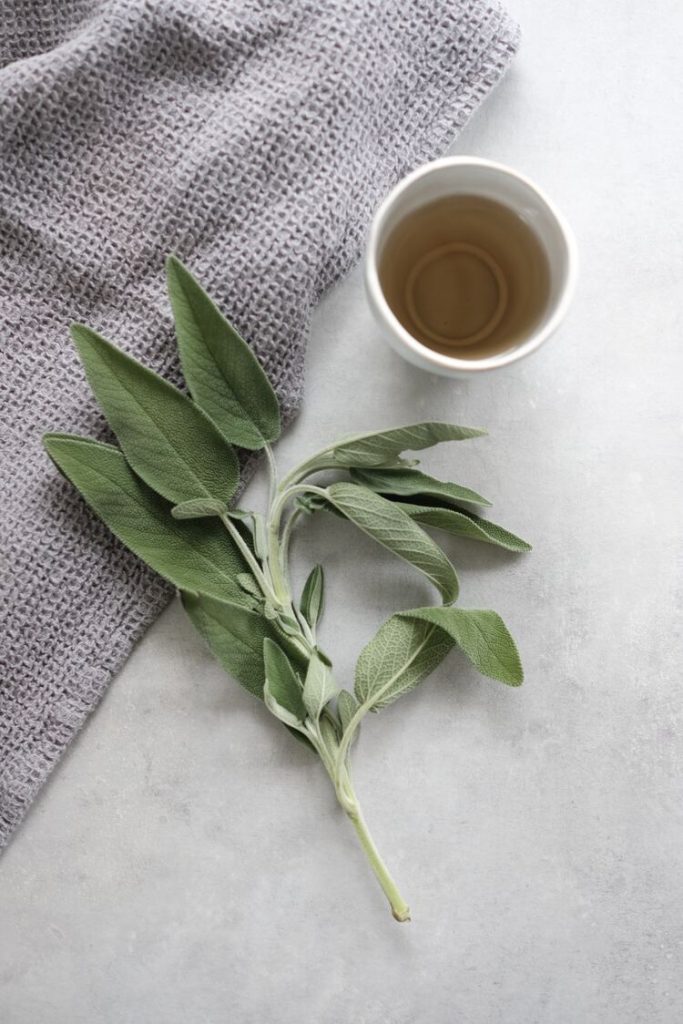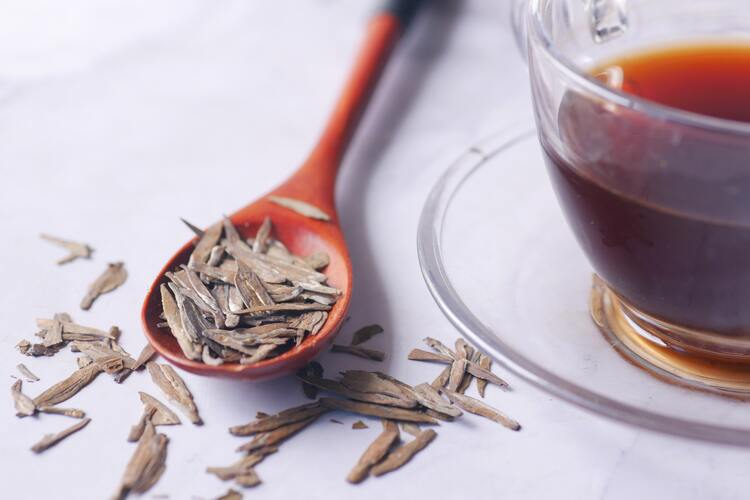What does sage tea taste like?
When you take your first sip, you’ll notice the tea has an earthy, slightly sweet, and somewhat savory flavor. The subtle minty undertones are accompanied by a hint of camphor, creating a unique and soothing taste. As you continue to enjoy your cup, you’ll begin to appreciate the warmth and complexity of this aromatic beverage.
If you want to treat your taste buds, keep reading to learn more about sage leaf tea!
Please note: This article contains affiliate links, meaning I may earn a commission if you make a purchase by clicking a link. Of course, this comes at no extra cost to you and helps me keep offering readers solid information.

What Does Sage Tea Taste Like?
Sage tea is a herbal tea made from the leaves of the sage plant, scientifically known as Salvia officinalis. Sage is native to the Mediterranean region but is now cultivated in many parts of the world. It has a long history of culinary and medicinal use.
When trying sage tea, you’ll immediately notice several different flavors. The overall taste can be earthy and slightly bitter, but it’s perfectly balanced with a subtle sweetness.
One of the first flavor notes you could detect is mint. Sage belongs to the same family as mint, and this connection is evident in the refreshing quality of the tea. This minty flavor is accompanied by a hint of pine – a gentle, woodsy undertone that gives the tea a pleasantly aromatic touch. Some people detect a citrus flavor as well.
While steeping sage tea, you can’t help but be drawn by its captivating aroma. The scent of sage tea is slightly spicy, yet it retains a delicate balance of sweet and earthy tones. This combination is one of the reasons you might find yourself turning to sage tea as a comforting, invigorating beverage.
As you continue to enjoy your cup of sage tea, remember that the harmonious balance of flavors – earthy, sweet, bitter, minty, and pine – creates its distinctive taste and aroma.
Sage Tea Preparation
You can use fresh and dried sage to prepare a delicious cup of sage tea. Using fresh sage leaves will provide a slightly different taste, as it will be more aromatic. Here’s a simple method to make your tasty sage tea.
First, gather your ingredients. You will need:
- 2-3 fresh sage leaves or 1-2 teaspoons of dried sage
- 1 cup of water
- Optional: honey, lemon, or sugar to taste
Begin by boiling the water in a pot or a kettle. Once the water boils, place your fresh sage leaves or dried sage in a teapot or a cup. Pour the boiling water over the sage and let it steep for about 5 minutes. The longer the sage steeps, the stronger the flavor will become.
While waiting for your sage tea to steep, you can prepare any additional ingredients you’d like to add for extra flavor. You can cut a lemon into slices, grab a spoonful of honey, or have some sugar handy.
After 5 minutes, strain the tea into a serving cup if you use fresh sage leaves. If you use dried sage, you can remove the tea infuser. Now, you can customize your tea to your liking. Add honey, lemon, or sugar to taste, and enjoy your comforting cup of sage tea.

Sage and Other Herbs
Sage tea is a popular herbal tea that belongs to the mint family, just like some of your other favorite tea options. Suppose you’re a fan of herbal teas. In that case, you might notice some similarities and differences between sage and other common herbs used in teas, such as chamomile, peppermint, thyme, eucalyptus, citrus, and ginger.
Chamomile tea is a go-to choice for many seeking a calming, soothing experience. Unlike the earthy taste of sage, chamomile has a mild sweetness with a hint of floral undertones.
Peppermint tea, another member of the mint family, offers a superb, refreshing taste that can cleanse your palate and invigorate your senses. While sage has some minty notes, it leans toward an earthy flavor profile.
Thyme, also part of the mint family, has a flavor comparable to sage. Thyme tea exhibits a woodsy, earthy taste with subtle minty undertones, making it a close relative of sage in terms of taste.
Meanwhile, eucalyptus tea is known for its distinctive, refreshing aroma and taste, which come from the eucalyptus tree’s leaves. This tea has a sharp, menthol-like flavor, quite different from the earthiness of sage tea.
Citrus notes are often found in teas, including the zest, peels, or juice from oranges, lemons, or other citrus fruits. These teas provide a bright, tangy, and refreshing flavor that can complement the earthy base of sage tea.
Ginger tea, with its warm and spicy taste, contrasts the cool, refreshing notes found in many herbal teas. Combining sage and ginger in a tea blend can offer a balanced mix of earthy and spicy flavors, creating a pleasant sensation on your palate.
As you explore herbal teas, remember that each offers a unique sensory experience. With its earthy and slightly bitter taste, Sage tea provides a distinct flavor profile that sets it apart from other herbal teas. Give it a try and see how it compares to your herbal favorites!
Sage Tea Health Benefits
Sage tea provides you with numerous health benefits!
One of the most notable benefits is its ability to soothe a sore throat due to its anti-inflammatory properties. Drinking sage tea can help alleviate pain and reduce inflammation, making it an ideal choice when experiencing a sore throat.
The tea also contains antioxidants, which help to protect your cells from damage caused by free radicals. These antioxidants help prevent many chronic diseases, including heart disease and cancer. In addition, sage tea is believed to aid digestion, contributing to overall better gut health.
Another great advantage of sage tea is its potential to improve memory and cognitive functions. Consuming sage tea might help you stay sharp and focused throughout the day. Additionally, it has been reported to help with hot flashes during menopause, providing relief from discomfort.
Sage tea contains Vitamin K, crucial in blood clotting and maintaining bone health. A cup of sage tea can help you reach your daily recommended intake of this critical nutrient.
Furthermore, it may assist in regulating cholesterol levels and reducing the risk of diabetes, making it a beneficial addition to your daily routine.

Sage Tea Food Pairings
Here are some common food pairings that complement the flavors of sage tea:
- Lemon or citrus desserts: The citrusy notes in sage tea make it a wonderful accompaniment to desserts like lemon bars, citrus cakes, or lemon tarts.
- Roasted meats: his tea pairs well with roasted meats, particularly poultry such as chicken or turkey. The earthy and savory taste of sage complements the rich flavors of roasted meats, creating a delicious combination.
- Root vegetables: Sage tea’s herbal and earthy notes make it a great match for root vegetables like roasted potatoes, carrots, or parsnips.
- Cheese: Sage tea pairs particularly well with mild, creamy cheeses like goat cheese or brie. The herbal undertones of the tea contrast nicely with the smoothness of the cheese.
- Mediterranean dishes: Sage is often associated with Mediterranean cuisine, so it complements dishes like pasta, pizza, or grilled vegetables. It can add an herbal and aromatic element that complements the flavors of the Mediterranean ingredients.
Sage in Cooking
Sage is a popular spice in cooking due to its unique and refreshing taste. Its strong flavor pairs well with various meats like pork and lamb. You can also find sage as a key ingredient in stews and sausages, highlighting its versatility in the culinary world.
You can use garden sage to add some zest to your dishes by treating it as a seasoning. If you want to experiment with different flavors, combine sage with other spices like rosemary and basil. Mixing these spices can enhance the overall taste of your dishes.
In your cooking, you might find that adding a splash of lemon juice when using sage can brighten the flavors and give the dish a touch of acidity. This combination works exceptionally well with meats, elevating their taste to new heights.

Buying Recommendations
If you cannot access fresh sage leaves, you can find dried ones in local health food stores or specialty tea retailers. You can also acquire the leaves online. Here are our top recommendations:
Alvita Sage Leaf Tea Organic 24 Bags

Buddha Teas Organic Sage Leaf Tea

The Republic of Tea Gourmet Blackberry Sage Black Tea

Frequently Asked Questions
How does sage tea compare to other herbal teas in taste?
Sage tea has a unique flavor profile, quite different from other herbal teas. It has a warm and slightly earthy taste, with hints of bitterness and sweetness. While other herbal teas might have a fruity or floral taste, sage tea has a savory and aromatic quality that sets it apart.
Can you describe the flavor profile of sage tea?
Sage tea has a complex flavor profile that combines savory, sweet, and slightly bitter notes. The predominant taste is warm and earthy, with a hint of pine that gives the tea a refreshing quality. This is accompanied by a subtle sweetness, which helps balance out the earthiness and any bitterness present.
Would you consider sage tea to be a refreshing beverage?
Yes, sage tea can be considered a refreshing beverage. Its warm, earthy flavors and the hint of pine make it an invigorating and uplifting drink. It can be enjoyed hot or cold, so whether you’re looking for a cozy, comforting tea or a thirst-quenching iced beverage, sage tea fits the bill.
What are some recipes that can enhance the flavor of sage tea?
To enhance sage tea’s flavor, add complementary herbs and spices like lemon, honey, or even a touch of cinnamon to your brew. For a delicious twist, consider blending sage tea with another herbal tea, such as chamomile or mint. This adds a unique flavor and allows you to enjoy the benefits of multiple herbs in one delicious infusion.
Does the taste of sage tea change depending on its brewing method?
Yes, the taste of sage tea can vary depending on the brewing method used. Generally, longer infusion times and hotter water can produce a stronger flavor with more pronounced bitterness. To extract the best flavor, it’s recommended to use freshly boiled water and steep the sage leaves for about 5 to 7 minutes. You can adjust the steeping time and temperature to suit your taste preferences.
Do any health benefits of sage tea affect its flavor profile?
The health benefits of sage tea do not affect its flavor profile. However, it’s worth noting that sage tea is rich in antioxidants and has been linked to various health benefits, such as improved cognitive function, reduced inflammation, and better digestion. These benefits may make you appreciate the unique taste of sage tea even more as you enjoy its flavors and potential positive effects on your well-being.
It was so fun to write about sage tea! I encourage you to try it if you have not. I hope you have enjoyed the article!
To you, what does sage tea taste like?
More About Herbal Tea
What Does Peppermint Tea Taste Like?
What Does Mint Tea Taste Like?
What Does Ginger Tea Taste Like?
What Does Lemon Balm Tea Taste Like?
What Does Chamomile Tea Taste Like?
What Does Lavender Tea Taste Like?
What Does Mullein Tea Taste Like?
What Does Raspberry Leaf Tea Taste Like?